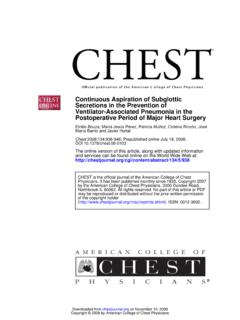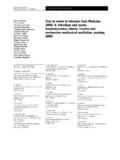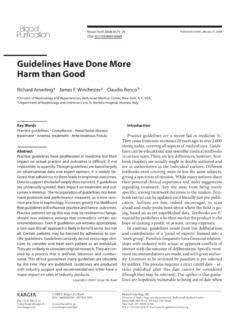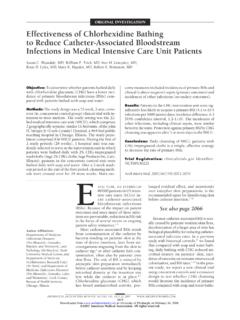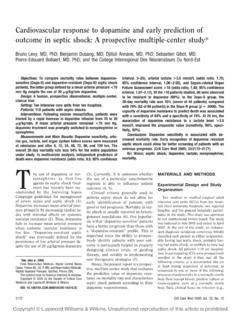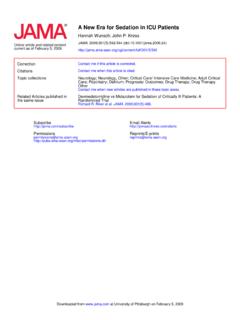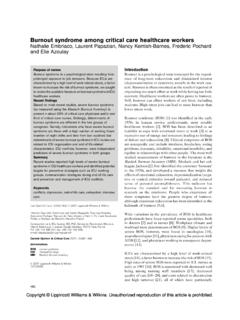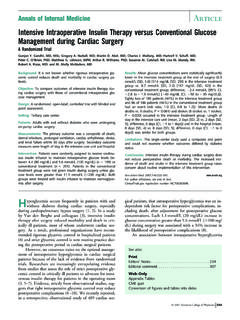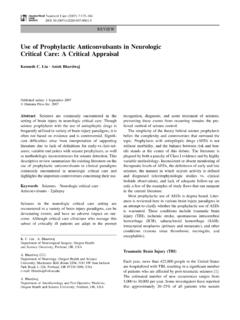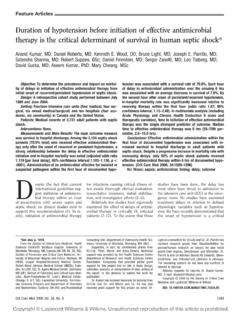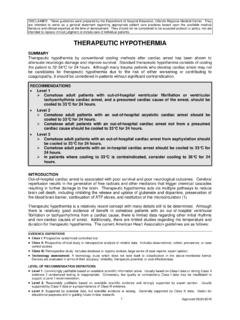Transcription of Hypothermia for neuroprotection after cardiac arrest ...
1 Review ArticlesHypothermia for neuroprotection after cardiac arrest : systematic review and individual patient data meta-analysisMichael Holzer, MD; Stephen A. Bernard, MD; Said Hachimi-Idrissi, MD; Risto O. Roine, MD, PhD;Fritz Sterz, MD; Marcus M llner, MD, MSc on behalf of the Collaborative Group on Induced Hypothermiafor neuroprotection after cardiac ArrestThe incidence of out-of-hospitalsudden cardiac arrest in in-dustrial countries ranges to of the total pop-ulation per year (1, 2). Of those patientsadmitted to the hospital, only 11 48%will be discharged from the hospital withgood neurologic outcome (3 17).For successful resuscitation with fa-vorable neurologic recovery, it is impor-tant not only to stop the ischemia processcaused by cardiac arrest as fast as possiblebut also to overcome the following pos-tresuscitation syndrome (18, 19), whichconsists of four different damagingpathomechanisms: a) perfusion failure(multifocal no-reflow, transient globalhyperemia with delayed, prolonged globaland multifocal hypoperfusion) (20); b)reoxygenation injuries (oxygen free radi-cals, invasion of inflammatory cells,electron conduction defects in injuredmitochondria, and an increase of exci-tatory amino acids) (21 23), whichcould lead to primary necrosis (24, 25)and/or triggering of programmed celldeath (apoptosis) (21, 26); c) extracere-bral causes (postanoxic viscera) (27).
2 And d) blood derangement during stasisin cardiac arrest (28).Clinical and experimental resultsshow a multifactorial neuroprotective ef-fect of Hypothermia during and after isch-emic situations by simultaneously influ-encing several damaging pathways (23,29 40).Recently, two trials showed that in-duced Hypothermia has a neuroprotectiveeffect in patients who could be primarilyresuscitated from cardiac arrest (41, 42).We therefore undertook a systematic re-view of the literature and performed anindividual patient data meta-analysis ofall identified trials. We looked at the ther-apeutic effect of induced Hypothermia insurvivors of primary cardiac AND METHODSWe searched for trials where therapeutichypothermia (any target temperature 35 C)was applied within 6 hrs after arrival at theemergency department.
3 We included random-ized and quasi-randomized, controlled trialsin adult survivors of cardiac arrest . We ex-From the Department of Emergency Medicine,General Hospital Vienna, Medical University of Vienna,Vienna, Austria (MH, FS, MM); Intensive Care Unit,Dandenong Hospital, Dandenong, Australia (SAB); De-partment of Critical Care Medicine and Cerebral Re-suscitation Research Group, AZ-VUB, Free University ofBrussels, Brussels, Belgium (SH-I); and Department ofNeurology, Helsinki University Central Hospital, Hel-sinki, Finland (ROR).Supported, in part, by grants from the Biomedicineand Health Programme (BIOMED 2) implemented underthe Fourth RTD Framework Programme 1994 1998 ofthe European Union (BMH4-CD-96-0667) (the Hypother-mia after cardiac arrest trial); by grants GZ and GZ from the Austrian Min-istry of Science and Transport; and by grant P11405-MEDfrom the Austrian Science requests for reprints to: Marcus M llner,MD MSc, Universit tsklinik f r Notfallmedizin, Allge-meines Krankenhaus der Stadt Wien, 1090 Wien,W hringer G rtel 18-20/6D, Austria.
4 2005 by the Society of Critical CareMedicine and Lippincott Williams & WilkinsDOI: :Only a few patients survive cardiac arrest withfavorable neurologic recovery. Our objective was to assesswhether induced Hypothermia improves neurologic recovery insurvivors of primary cardiac Source:Studies were identified by a computerized searchof MEDLINE, EMBASE, CINAHL, PASCAL, the Cochrane ControlledTrial Register, and Selection:We included randomized and quasi-random-ized, controlled trials of adults who were successfully resusci-tated, where therapeutic Hypothermia was applied within 6 hrsafter arrival at the emergency department and where the neuro-logic outcome was compared. We excluded studies without acontrol group and studies with historical Extraction:All authors of the identified trials suppliedindividual patient data with a predefined set of Synthesis:We identified three randomized trials.
5 Theanalyses were conducted according to the intention-to-treat prin-ciple. Summary odds ratios were calculated using a randomeffects model and translated into risk ratios. More patients in thehypothermia group were discharged with favorable neurologicrecovery (risk ratio, ; 95% confidence interval, ).The 95% confidence interval of the number-needed-to-treat toallow one additional patient to leave the hospital with favorableneurologic recovery was 4 13. One study followed patients to 6months or death. Being alive at 6 months with favorable func-tional neurologic recovery was more likely in the hypothermiagroup (risk ratio, ; 95% confidence interval, ).Conclusions:Mild therapeutic Hypothermia improves short-term neurologic recovery and survival in patients resuscitatedfrom cardiac arrest of presumed cardiac origin. Its long-termeffectiveness and feasibility at an organizational level need fur-ther research.
6 (Crit Care Med 2005; 33:414 418)KEYWORDS: ventricular fibrillation; asystole; hypoxia-ischemia;brain; reperfusion injury; hypothermia414 Crit Care Med 2005 Vol. 33, No. 2cluded studies without a control group andstudies with historical searched MEDLINE, EMBASE, CI-NAHL, PASCAL, the Cochrane Central Regis-ter of Controlled Trials, and BIOSIS from 1990until November 2002. We used a filter to iden-tify randomized controlled trials, a filter forthe intervention, and a filter for the language restrictions were applied. We alsoscanned the references of relevant studies andreviews. To identify unpublished studies, theprincipal investigators of the three random-ized trials were asked whether they knew ofany other randomized trials in this primary outcomes of interest wereshort-term outcome and long-term short-term outcome was defined asgood neurologic recovery and discharge fromthe hospital.
7 Favorable long-term outcomewas defined as good neurologic recovery andbeing alive 6 months after the event. Goodneurologic recovery was defined as con-scious, alert, sufficient cerebral function foractivities of daily life ( , dress, travel bypublic transportation, food preparation); mayhave hemiplegia, seizures, ataxia, dysarthria,dysphasia, or permanent memory or mentalchanges or better. This is, according to thecerebral performance categories (CPC) (43,44), a CPC score of 1 or assess the internal validity of trials iden-tified, we assessed allocation sequence gener-ation, allocation concealment, and blindedoutcome principal authors of the identified trialsagreed to supply individual patient data. Anal-yses were according to the intention-to-treatprinciple.
8 The principal measure of effect wasthe relative risk of favorable short-term andlong-term outcome in patients with hypother-mia compared with patients without inducedhypothermia. We used random effects logisticregression and generalized linear mixed mod-els to analyze individual patient data (45). Adetailed description of the modeling proce-dure used can be provided on Review of the systematic search of databases of themedical literature resulted in 991 we excluded hits referring to othertreatment modalities than hypothermiaor other diseases than resuscitation fromcardiac arrest and articles not containingoriginal data, seven controlled studies re-mained. Three studies used historicalcontrols (46 48), and four trials wererandomized and quasi-randomized (41,42, 49, 50). One trial (50) was excludedbecause it investigated whether applica-tion of Hypothermia during advanced car-diac life support was of Included three relevant trials where hy-pothermia was applied after primarilysuccessful resuscitation (41, 42, 49).
9 Onetrial involved nine centers in five Euro-pean countries where 275 patients wereenrolled (41). Comatose survivors of wit-nessed ventricular fibrillation cardiac ar-rest of presumed cardiac origin were ran-domized to standard or mild hypothermiatherapy (target bladder temperature 32 34 C) for 24 hrs. Hypothermia was ap-plied by means of a blanket that coveredthe whole body and released cooled random sequence was computer gen-erated and concealed by using opaqueenvelopes. Outcome assessors wereblinded to the intervention. Two patientswere lost to neurologic trial involved four centers in Aus-tralia where 77 patients were enrolled(42). Comatose survivors after ventricu-lar fibrillation cardiac arrest were in-cluded. Patients were assigned to mildhypothermia on odd days and regulartreatment on even days.
10 Hypothermiawas applied by means of ice packs placedaround the head, neck, torso, and target pulmonary artery temperaturewas 33 C and was maintained until 12 hrsafter arrival. The outcome assessor wasblinded to the third trial took place in one of thecenters also participating in the Euro-pean multiple-center study (49). As theinclusion criteria were different, none ofthe patients were included in more thanone trial. The published article only re-ports on 30 patients. Here we report on33 patients, as follow-up was not com-pleted at the time of submission. In thistrial, comatose survivors of cardiac arrestwith a primary electrocardiographicrhythm of asystole or pulseless electricalactivity were enrolled. Systemic hypo-thermia was achieved with a helmet de-vice placed around the head and neck andcontaining a solution of aqueous glyc-erol.
